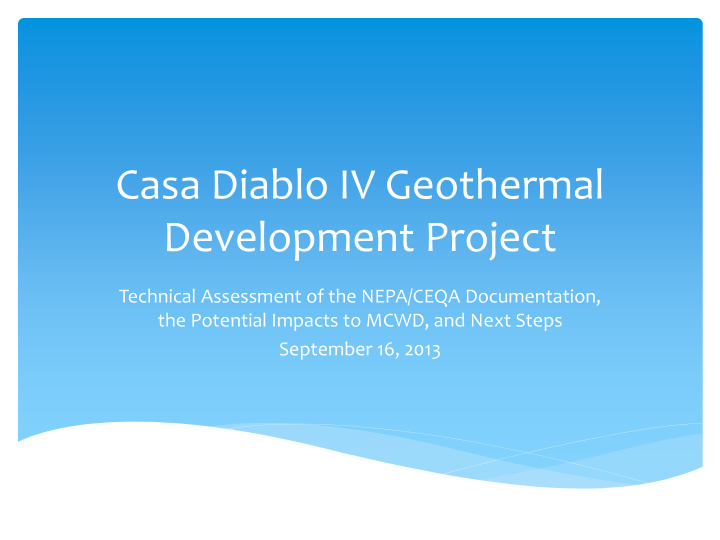



Casa Diablo IV Geothermal Development Project Technical Assessment of the NEPA/CEQA Documentation, the Potential Impacts to MCWD, and Next Steps September 16, 2013
CD IV Expansion 16 New geothermal well sites with 14 in Basalt Canyon Geothermal production will be increased from: 12,000 gpm to 18,000 gpm or 19,000 acre-ft/yr to 29,000 acre-ft/yr Injection wells will be located in the Casa Diablo area
Insert map 1
MCWD Review WEI reviewed portions of administrative copy of Joint NEPA/CEQA Document in July 2012 and provided comments WEI and Schmidt reviewed the draft Joint NEPA/CEQA Document and prepared comments in January and February 2013 MCWD submitted these to the lead agencies WEI provided a comment letter in July 2013 responding to the final Joint NEPA/CEQA Document’s response to the MCWD’s comments on the draft Joint NEPA/CEQA Document Finally, WEI provided a letter report in August 2013 outlining a recommended monitoring and mitigation plan
Joint NEPA/CEQA Conclusions Regarding the Degree of Hydraulic Connection Joint NEPA/CEQA Document concludes: Shallow cold-groundwater system is hydraulically isolated from the geothermal system Ormat assumed no impact to the shallow cold-groundwater system – no definitive analysis to confirm assumption Therefore no impacts were projected to the cold groundwater system and MCWD Computer simulations of the geothermal reservoir described in the Joint NEPA/CEQA Document did not include simulation of the cold groundwater and geothermal systems together No mitigation of impacts to the cold groundwater were required because no impacts were assumed
WEI/Schmidt Conclusions Inadequate hydrogeologic characterization There is a two to three square-mile area between the proposed and existing geothermal wells in the Basalt Canyon and the District’s well field for which no boreholes have been drilled or wells constructed. This means that the hydrogeology in this area has not been characterized No analysis of hydraulic connectivity has ever been done There is no technical basis for the certainty of no impacts to the cold groundwater system and to MCWD as expressed in the Joint NEPA/CEQA Document
WEI/Schmidt Conclusions MCWD concerns: The expansion of geothermal production nearer the MCWD wells will induce downward flow of groundwater and reduce the groundwater resource available to the MCWD There is some evidence of connectivity at MCWD well 17 The impact could take years to manifest itself and reduce the availability of groundwater during dry-years May reduce the surface water discharge in Mammoth Creek and impair beneficial uses of that supply
The Way Forward The BLM and FS have entered a Record of Decision (ROD) on the NEPA document The Great Basin Unified APCD has stated it would defer certification of the CEQA document pending the development of a monitoring and mitigation plan acceptable the MCWD MCWD and Ormat have verbally agreed to attempt to develop a monitoring and mitigation plan – we start this process later this month
Mitigation Plan The MCWD requires that the monitoring and mitigation plan be defined prior to project approval Metrics need to be developed with thresholds or “bright - lines” that trigger mitigation of known capacity
Two-Part Monitoring Plan Part 1 – Conduct aquifer stress tests to determine hydraulic connectivity before the CD-IV wells are constructed Ormat should construct at least four new monitoring well pairs with each pair consisting of a new geothermal well and an existing or new cold groundwater well Ormat will stress either the cold or geothermal system in each well pair and measure response to determine hydraulic isolation
Two-Part Monitoring Plan Part 2 – Conduct new and continuous monitoring to determine if the CD-IV project is impacting the cold- groundwater system – needs to be implemented before the CD-IV wells are operational Piezometric measurements in select wells including the new cold and geothermal well pairs Chemistry and physical property measurements in select wells including the cold and geothermal well pairs
Next Steps Develop monitoring and mitigation plan with Ormat; Develop and execute the monitoring plan Develop a mitigation plan Develop metrics & triggers, and the monitoring required to evaluate metrics and assess if a “triggering” event has occurred
Questions?
End
Insert map 2
Insert map 2
Insert map 1
Recommend
More recommend